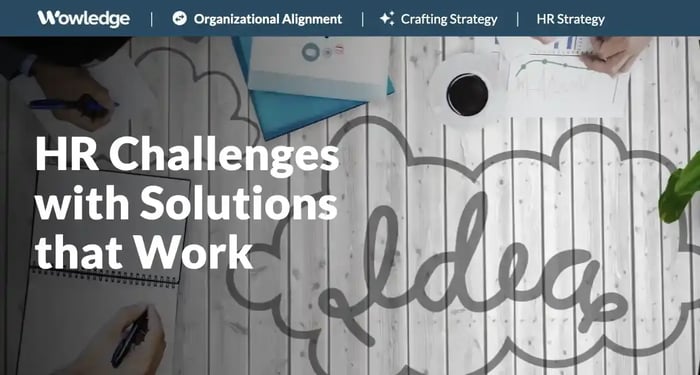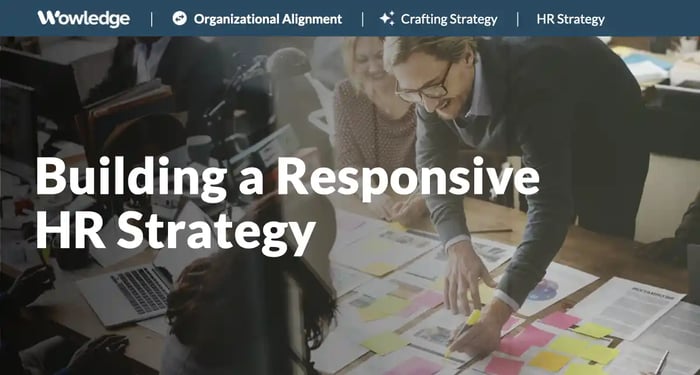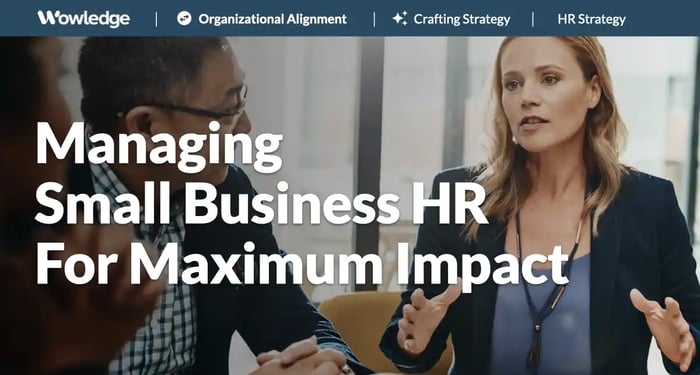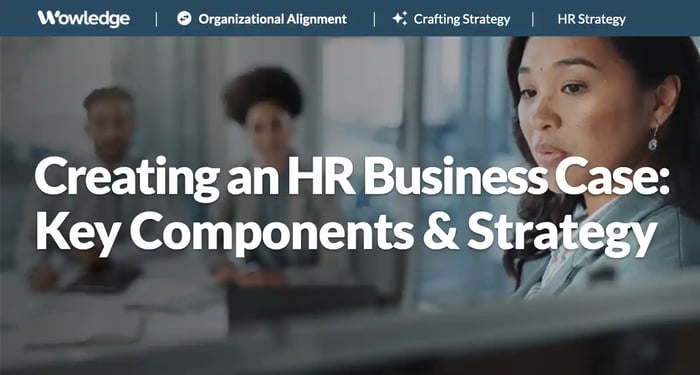Table of Contents
Is your small HR team fighting to consistently balance business with people contributions?
The life of a Human Resources leader is rarely dull, always full of opportunities to be overleveraged by the challenges tossed their way. Having led HR teams both large and small, we've found that while business issues and requirements are often similar (e.g., pressures to produce sufficient and timely hiring, retention and engagement of the workforce), the challenges with smaller teams tend to be unique and/or magnified.
First, what do we consider a “small HR team? Indeed reports average HR: Employee ratios of 2.57 per 100 employees for all organizations (closer to 1:100 for medium to large firms), while peoplemanagement reports that the majority (70%) of companies that had an average of 1000 or fewer employees have 10 or fewer HR employees. In our experience, a team of several HR generalists and two to four specialists or administrators supporting either a smaller company or a division of a larger company is very common, with ratios well in excess of 1 HR business partner (HRBP) covering 1,000 employees increasingly commonplace.
Keep in mind that in larger organizations, centralized shared services and centers of excellence (COEs) typically provide common-need support for administrative and related HR tasking, while in smaller companies some level of outsourced services (payroll, benefits, etc.) are similarly leveraged. In both cases, however, some level of local administrative or specialist support is needed, and balancing the daily tasks associated with those vs. broader strategic contributions is the conundrum that smaller HR teams regularly face.

The common issues smaller HR teams face
1. Balancing the strategic and non-strategic
When evaluating the ability to meet requirements for strategic contributions to help drive business objectives, a common refrain heard is the coinciding need to reduce ongoing or recurrent administrative and specialist workloads. We have found that small HR teams still struggle to provide a full array of strategic services and plans as they find themselves bogged down in managing or facilitating recurring work related to issues with employee relations, payroll, annual performance and merit cycles, HR systems, annual benefits enrollment, and so on.
2. Managing resource shortages
Sometimes, it is simply a too-full agenda combined with a team without enough resources to manage all that is required. It may be that budget and staff cuts in HR have taken away certain capabilities that must be fulfilled elsewhere, if at all. It may be a canceled technology project that requires continuing (or reverting to) labor-intensive processing. Whatever the situation, sometimes there are just not enough staff and hours available to accomplish everything that is required and desired.
3. Filling skill gaps
Probably the most common issue is a lack of expertise that exists on a small team. Given the very nature of the HR business partner (HRBP) or generalist role, the more of these you have, the more likely it is that most of those have more breadth of experience rather than depth, depending on their career arcs. Just think about how many smaller HR teams lack deep and local expertise in organization development methodologies, alternative rewards, executive development, advanced people analytics, etc. While those topics may not require ongoing management, when they do arise, the pain is often acutely experienced in a small HR team.
4. Challenging business credibility
With fewer resources and the need for some staffers to be specialists in topics such as payroll or benefits administration, learning or recruiting, there are fewer resources available to act in broader strategic partnership with line leaders. The outcome is frequently that the small HR team is viewed by some leaders as an administratively focused function, which can limit what HR is expected to contribute. While many HR roles can become strategic in nature (for example, a learning professional conducting performance consulting or a recruiter providing workforce planning projections), they are often bogged down in day-to-day management of their core processes.

So how can these challenges be addressed?
1. Enhance strategic contributions
Start by first assessing the impact of all existing HR processes and efforts on business priorities and needs. The more that different HR capabilities and activities directly drive actual business objectives, the clearer a picture of their prioritization comes to light. A useful exercise involves assessing the business criticality of all key HR processes, practices, and capabilities into a 2X2 matrix that combines a rating of each one’s Impact on the business with its Difficulty/cost of implementation. For example:

Next, use the processes and practices that are either low impact and/or more difficult/costly to implement to identify opportunities for leveraging process reengineering, lean methodologies, or design thinking to redesign lower-value processes and practices to make them less labor-intensive while more user-friendly. In support of such redesign efforts, track employee and manager requests and inquiries and use that information to create end-user tools that are self-explanatory and/or develop a knowledge portal for FAQs that can be referenced. An additional look into and even testing of the use of chatbots for handling questions and inquiries can serve to further optimize handling what tends to be a large set of standard employee and manager inquiries.
Once opportunities to reduce the need for high-volume administrative activities have been identified and dealt with, consider a realignment of the existing team allocation to address the highest strategic value activities, such as internal consulting and tailoring HR practices to meet the targeted needs of critical workforce segments.
2. Manage with other resources
Start by formally resetting expectations with management and employees about what can and will be delivered, with how strategic business requirements will be met while maintaining lower-value (but necessary) HR services (see Strategic Change Management guidance). Next, consider additional investments in manager skill building that, while avoiding adding HR work to their plates (an all-too-common and disliked occurrence), focus on syndicating HR’s expertise by developing their ability to better handle their own basic and routine employee issues. That translates into process redesign (e.g., more frequent check-ins and feedback in performance management) and management development (e.g., identifying and handling wellness issues, advanced delegation-for-development skills, agile team management, etc.)
Further considerations that expand HR resources include outsourcing non-strategic processes such as payroll or benefits administration, HR and Safety compliance, and basic employee relations and legal claim management. Also consider partnering with local universities’ HR management programs for conducting HR projects, performing research, and offering internships for class credit.
3. Close skill gaps
Core to understanding how to fill gaps in expertise is defining what type of support is needed – an extra “pair of hands,” expert, or collaborator (per Peter Block’s Flawless Consulting).
A pair of hands refers to short-term, temporary, or part-time help that can often be found via an underutilized new hire or college hire in another department. Such roles can also be filled by temps, interns, or summer hires who do not require deep expertise.
An expert with capabilities that do not exist on the team can be found by partnering with other functions and line organizations to produce strategic work on a project basis, such as the creation of an enhanced HR KPI dashboard (with IT or other existing analytics teams) or the redesign of an employee-facing process using design thinking (from the engineering or marketing function). Obviously, external consultants can be leveraged here as well.
A collaborator can have team member(s) either work with internal or external experts, attend cross-training, send them to conferences to learn, or assign them as project leaders or team members on a project team with an outside consulting firm to learn firsthand. Again, external consultants can be valuable to bring in on such projects, and the collaboration is a learning and development mechanism to build new capabilities and expertise on the existing team.
Another key opportunity with positive long-term impact is reorganizing the HR team to develop expertise – with rotations to add specialized depth to HRBP’s (e.g., assign a functional specialty to develop expertise such as employee engagement) or specialists with another skill (assigning expatriate compensation to a compensation specialist) related to the needs of the business.
In this case, offer advanced training for each staffer, then have each build a strategy, and finally develop programs to address relevant issues. Examples of tailored specialties that can meet current trends include employee mobility, career development, remote work policies, non-traditional compensation/rewards, coaching and mentoring, and employee listening, among others.
4. Build and enhance credibility
Expectations from business leaders can at times be lower, given the size of the team and the scale of issues to be dealt with. Counter this by emphasizing a business focus on everything – goals, strategies, practices, communications, and metrics/reporting. HR leaders should challenge their staff’s thinking with both questions and collaborative thinking regarding business context, including a group translation of business goals into HR objectives as a team.
Attendance (and active participation) in internal client staff and business/operational and strategic planning meetings should be mandatory, as should the practice of coming back to the HR team with observations, trends, and questions from such meetings on a regular basis (e.g., in the next HR staff meeting). Finally, build a formal alignment with Finance, Marketing, Operations, and other functions by arranging regular HR staff briefings on new initiatives, goals, results, and initiatives. A better-educated HR team is one that is better prepared to contribute to the business as a true partner.
Final thoughts
The establishment of HR as a key resource in the development and management of the business is a common goal, and one that can be achieved regardless of team size. Above all, the focus of a smaller HR team should always be supporting the business and its primary objectives, while managing the administrative and process requirements that tend to act as irritants or distractions when they are not well-run. Core to this is the role of the pioneering HR Leader, who is fearless, bold, and resourceful in addressing the various challenges faced while developing and guiding a cadre of HR resources that can deliver consistent value to the business.
Relevant Practices & Tools
Core HR Strategy Practices to Define a Foundational Direction for the HR Function. >
An HR Strategy sets business-based human resource (HR) tactics that will constitute a comprehensive multi-year approach to managing the HR function's structure... more »
Understanding Business Strategies to Align the HR Direction. >
Core to the development of an HR strategy is building an understanding of the key business strategies and initiatives that must be accomplished during the term of the plan... more »
Developing a Base Strategy that Provides Guidance on HR Direction, Initiatives, Objectives, and Goals. >
Developing a plan involves leveraging the outcomes of the various discovery activities, organizing them into a logical flow, and translating those insights into HR responses... more »
Conducting Performance Consulting-based Learning Needs Assessments for Specialized Solutions. >
“Performance Consulting” is the act of resolving workplace performance shortcomings by using a disciplined approach to learning needs assessments... more »
The Performance Consulting Assessment Tool: Uncover Workforce Challenges and Supporting Data for Learning and Development Solutions. >
The Performance Consulting Assessment Tool documents conversation(s) with functional managers who are facing specific workforce challenges that the learning & development team... more »
FAQs
When is HR outsourcing preferable to automation or shared services?
Outsourcing makes sense when the work is rules-based, volume-volatile, or compliance-heavy, and when a credible vendor can guarantee quality and continuity at lower total cost. Automation or self-service is preferable for stable, high-volume transactions with clear decision logic that benefits from tight integration with internal systems. Shared services win when scale exists across units, the process and its inputs and outputs are well-defined and stable over time, but institutional knowledge and access to internal data are essential.
How can manager enablement reduce HR workload without dumping HR work onto managers?
The focus should be on skill-building that prevents issues upstream: clearer role outcomes, better feedback routines, and earlier risk spotting in attendance, performance, or well-being. Provide templated guides, short practice labs, periodic and ongoing group coaching and support, and just-in-time tools (e.g., prompts, scripts) embedded in the systems managers already use. Success is measured by sustained reductions in avoidable trouble tickets and faster cycle times for routine actions, rather than by the number of training hours delivered.
What minimum data reporting allows HR to plan and act credibly when analytics resources are thin?
A pragmatic baseline includes headcount and turnover trends, hiring volume (and losses) for critical roles, internal fill rates, pulse indicators of change readiness, and unit-level productivity or cost anchors validated with Finance. Where data is missing, assumptions should be stated with confidence levels and near-term replacement plans to avoid false conclusions. The aim is directional clarity that supports prioritization, not a perfect model.
How should a small HR team close capability gaps without adding permanent hires?
Match the need to the engagement type: a temporary “pair of hands” (e.g., temps) for production surges, a targeted expert (e.g., contractor) for discrete deliverables, and a collaborator model (e.g., consultant) when capability transfer is required. Internal partners in IT, Finance, or Operations can co-own analytics, process redesign, or KPI dashboards, supplemented by short-cycle consulting sprints using cross-functional employees. Each engagement should include a knowledge handoff to ensure the team’s baseline capability ratchets up after delivery.










